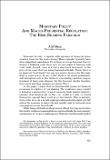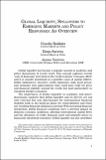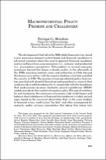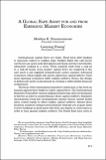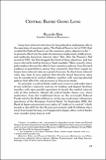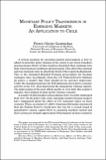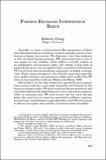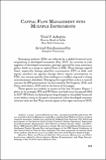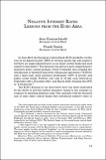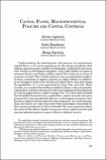Buscar
Mostrando ítems 121-130 de 135
Monetary policy and macro-prudential regulation: the risk-sharing paradigm
Economic history is replete with episodes of financial crises creating havoc for the real economy. These episodes typically have three important ingredients. First there are large financial flows to finance a bubbling asset class such as sovereigns or housing with 'safe' debt. Second there is a sharp ...
Global liquidity spillovers to emerging markets and policy responses: an overview
Global liquidity has become a popular concept in academic and policy discussions of recent years. This concept captures overall 'ease of financing' prevalent in the world economy (Caruana 2013) and it is usually mentioned as a possible cause of capital inflows global imbalances excessive credit expansion ...
Macroprudential policy: promise and challenges
The developments that led to the 2008 global financial crisis raised a new awareness amongst central banks and financial regulators in advanced economies about the need to approach financial regulation and surveillance from a macroeconomic (i.e. systemic) and prudential (i.e. pre-emptive) perspective. ...
A global safe asset for and from emerging market economies
International capital flows are fickle. Short-term debt funding is especially subject to sudden stops. Sudden flight into safe-haven currencies can cause large disruptions and sharp currency movements ultimately leading to a crisis. When markets shift from a risk-on to a risk-off mood cross-country ...
Central banks going long
Long-term interest rates have for long played an ambiguous role in the operation of monetary policy. The Federal Reserve Act of 1913 that created the Federal Reserve set the monetary policy objective to be: '... to promote effectively the goals of maximum employment stable prices and moderate long-term ...
Monetary policy transmission in emerging markets: an application to Chile
A critical question for emerging-market policymakers is how to adjust to monetary policy changes in the center. A core tenet of modern macroeconomic theory is that countries should let their exchange rate float when financial conditions abroad change. This allows the nominal and real exchange rates ...
Foreign exchange intervention redux
Arguably no issue in International Macroeconomics exhibits more dissonance between academic research and policy practice than foreign-exchange intervention. The dominant view from academia is that sterilized foreign-exchange (FX) intervention has a tiny if any impact on real variables which makes it ...
Capital flow management with multiple instruments
Emerging markets (EMs) are affected by a global financial cycle originating in developed economies (Rey 2013). An increase in risk appetite of developed economies perhaps spurred by easy monetary policy leads to a surge in capital flows to EMs. These foreign capital flows especially foreign portfolio ...
Negative interest rates: lessons from the Euro area
In June 2014 the European Central Bank (ECB) decided to cut the rate on its deposit facility (DFR) by 10 basis points (bp) into negative territory an unprecedented move as no major central bank had used negative rates before. This decision was part of a more comprehensive monetary policy easing package ...
Capital flows macroprudential policies and capital controls
Understanding the determinants and patterns of international capital flows is of crucial importance for the design of policies that enhance macroeconomic stability. Traditionally capital flows have been very volatile in developing economies with large inflows in times of economic booms and large sudden ...

